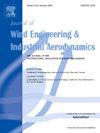Experimental study on a novel wind gust generator based on an adaptive nozzle design
IF 4.2
2区 工程技术
Q1 ENGINEERING, CIVIL
Journal of Wind Engineering and Industrial Aerodynamics
Pub Date : 2025-03-14
DOI:10.1016/j.jweia.2025.106080
引用次数: 0
Abstract
The paper presents a novel design of a wind gust generator based on an adaptive nozzle for wind tunnel applications and its experimental investigation. The key feature of this design is the movable upper wall of the nozzle, which adjusts the cross-section of the nozzle’s outlet. For this purpose, the upper contour of the nozzle is connected to a programmable and fast-moving tooth belt axis, enabling rapid changes in the nozzle geometry to generate reproducible horizontal wind gusts that develop along a flat ground plate. The experimental setup primarily relies on particle-image velocimetry as an optical measurement technique, supported by a constant-temperature anemometer and pressure taps at specific locations. The gusts are generated using a well-defined motion pattern of the movable nozzle, following a -type signal. A combination of velocity and surface pressure measurements is carried out, analyzing the gust development at various positions along the ground plate in streamwise direction. Both data sets are used to quantify the adaptive nozzle’s potential as an effective tool for wind gust generation, facilitating future studies on highly dynamic fluid–structure interactions under wind gust load. Additionally, the well-designed experiment is planned to serve as a valuable validation case for numerical methods.
基于自适应喷管设计的新型阵风发生器实验研究
本文提出了一种新的基于自适应喷管的风洞型阵风发生器设计及实验研究。该设计的主要特点是喷嘴的上壁可移动,可调节喷嘴出口的横截面。为此,喷嘴的上轮廓连接到可编程和快速移动的齿带轴,从而实现喷嘴几何形状的快速变化,从而产生沿平坦地面发展的可重复的水平阵风。实验装置主要依靠粒子图像测速作为一种光学测量技术,由恒温风速计和特定位置的压力水龙头支持。利用可移动喷嘴的明确运动模式,跟随(1 - cos)型信号产生阵风。结合风速和地面压力的测量,分析了沿地面各位置的阵风沿流方向的发展情况。这两个数据集用于量化自适应喷嘴作为阵风产生有效工具的潜力,促进未来在阵风载荷下高动态流固相互作用的研究。此外,精心设计的实验计划作为数值方法的有价值的验证案例。
本文章由计算机程序翻译,如有差异,请以英文原文为准。
求助全文
约1分钟内获得全文
求助全文
来源期刊
CiteScore
8.90
自引率
22.90%
发文量
306
审稿时长
4.4 months
期刊介绍:
The objective of the journal is to provide a means for the publication and interchange of information, on an international basis, on all those aspects of wind engineering that are included in the activities of the International Association for Wind Engineering http://www.iawe.org/. These are: social and economic impact of wind effects; wind characteristics and structure, local wind environments, wind loads and structural response, diffusion, pollutant dispersion and matter transport, wind effects on building heat loss and ventilation, wind effects on transport systems, aerodynamic aspects of wind energy generation, and codification of wind effects.
Papers on these subjects describing full-scale measurements, wind-tunnel simulation studies, computational or theoretical methods are published, as well as papers dealing with the development of techniques and apparatus for wind engineering experiments.

 求助内容:
求助内容: 应助结果提醒方式:
应助结果提醒方式:


